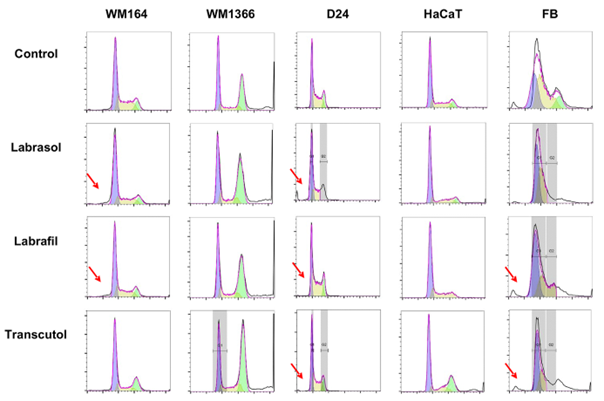In vitro screening of topical formulation excipients for epithelial toxicity in cancerous and non-cancerous cell lines
DOI:
https://doi.org/10.17179/excli2023-6072Keywords:
cytotoxicity, cell sensitivity, MTT, crystal violet, ROS, cell cycle analysisAbstract
Chemical excipients used in topical formulations may be toxic to living skin cells. Here, we compared the in vitro toxicity of some common solubilizing excipients against human melanoma cells, human keratinocytes (HaCaT) and primary skin fibroblasts (FB) as examples of cancerous, immortalized and primary human skin cells, often used as experimental models representative of in vivo conditions. Two distinct endpoint assays (3-(4,5-Dimethylthiazol-2-yl)-2,5-diphenyltetrazolium bromide (MTT) and crystal violet (CV)) were used. The mechanism of cell death after excipient exposure was assessed through Reactive Oxygen Species (ROS) production, cell membrane integrity and cell cycle progression. Results showed that the surfactants, Labrasol®, Labrafil® and Transcutol®, were less toxic than Triton X-100 (a model irritant) in all cell types whereas the oil, Labrafac®, was non-toxic. The human melanoma WM164 cell line showed the greatest sensitivity toward cytotoxicity after chemical exposure, while the other cell lines were more resistant. The relative excipient cytotoxicity responses observed in the MTT and CV assays were comparable and similar trends were seen in their estimated 50 % inhibitory concentration (IC50) values. DNA fragmentation by flow cytometry after exposing the cells to IC50 concentrations of the excipients showed negligible apoptotic populations. ROS production was increased in all cell types after toxic exposure; however, ROS elevation did not lead to apoptosis. The toxicity profiles of each excipient are not only relevant to their use in formulating safe topical products but also in the potential synergistic efficacy in the topical treatment of melanoma.

Downloads
Additional Files
Published
How to Cite
License
Copyright (c) 2023 Farzaneh Forouz , Yousuf Mohammed, Hamid S. A. Shobeiri Nejad , Michael S. Roberts, Jeffrey E. Grice

This work is licensed under a Creative Commons Attribution 4.0 International License.
Authors who publish in this journal agree to the following terms:
- The authors keep the copyright and grant the journal the right of first publication under the terms of the Creative Commons Attribution license, CC BY 4.0. This licencse permits unrestricted use, distribution and reproduction in any medium, provided that the original work is properly cited.
- The use of general descriptive names, trade names, trademarks, and so forth in this publication, even if not specifically identified, does not imply that these names are not protected by the relevant laws and regulations.
- Because the advice and information in this journal are believed to be true and accurate at the time of publication, neither the authors, the editors, nor the publisher accept any legal responsibility for any errors or omissions presented in the publication. The publisher makes no guarantee, express or implied, with respect to the material contained herein.
- The authors can enter into additional contracts for the non-exclusive distribution of the journal's published version by citing the initial publication in this journal (e.g. publishing in an institutional repository or in a book).





